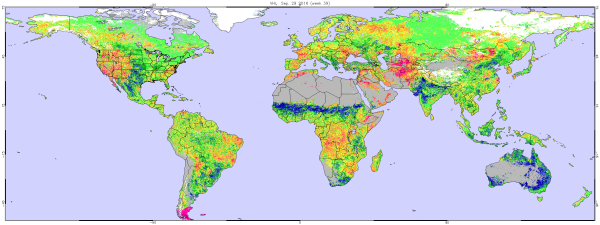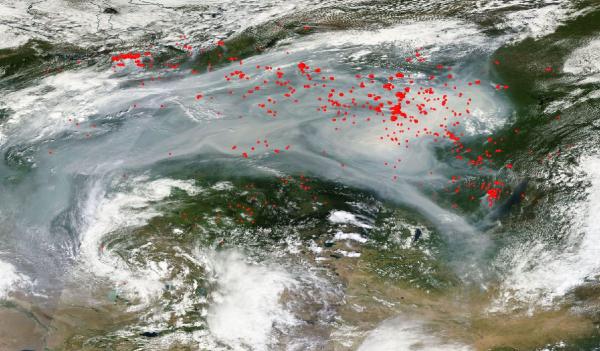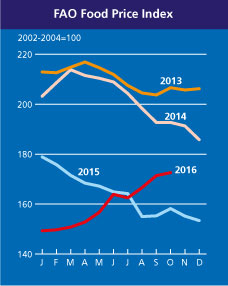With Temperatures Hitting 1.2 C Hotter than Pre-Industrial, Drought Now Spans the Globe
30
November, 2016
Jeff
Goodell, an
American author and editor at Rolling Stone,
is noted for saying this: “once we deliberately start messing with
the climate, we could inadvertantly shift rainfall patterns (climate
models have shown that the Amazon is particularly vulnerable) causing
collapse of ecosystems, drought, famine and more.”
We
are in the process of testing that theory. In the case of drought,
which used to just be a regional affair but has now gone global,
Goodell appears to have been right on the money.
****
According
to a recent report by the World Meteorological Organization,
the Earth is on track to hit 1.2 degrees Celsius hotter than
pre-industrial temperatures during 2016. From sea-level rise, to
melting polar ice, to extreme weather, to increasing numbers of
displaced persons, this temperature jump is producing steadily
worsening impacts. Among the more vivid of these is the current
extent of global drought.
The
Four-Year Global Drought
During
El Nino years, drought conditions tend to expand through various
regions as ocean surfaces heat up. From 2015 to 2016, the world
experienced a powerful El Nino. However, despite the noted influence
of this warming of surface waters in the Equatorial Pacific, widely
expansive global drought extends back through 2013 and farther.
(The
Global Drought Monitor finds that dry conditions have been prevalent
over much of the globe throughout the past four years. For some
regions, like the Colorado River area, drought has already extended
for more than a decade. Image source: SPEI
Global Drought Monitor.)
In
the above image, we see soil moisture deficits over the past 48
months. What we find is that large sections of pretty much every
major continent are undergoing at least a four-year drought. Drought
conditions were predicted by climate models to intensify in the
middle latitudes as the world heated up. It appears that this is
already the case, but the Equatorial zone and the higher latitudes
are also experiencing widespread drought. If there is a detectable
pattern in present conditions, it is that few regions have avoided
drying. Drought is so wide-ranging as to be practically global in its
extent.
Widespread
Severe Impacts
These
drought conditions have noted impacts.
In
California alone, more
than 102 million trees have died due
to rising temperatures and a drought that has lasted since 2010. Of
those, 62 million have perished just this year. Drought’s
relationship to tree mortality is pretty simple — the longer
drought lasts, the more trees perish as water stores in roots are
used up. California has, so far, lost 2.5 percent of its live trees
due to what is now the
worst tree mortality event in the state’s history.
(It’s
not just California. Numerous regions around the world show plants
undergoing life-threatening levels of stress. In the above map,
vegetative health is shown to be moderately stressed [yellow] to
severely stressed [pink] over broad regions of the world. Image
source:Global
Drought Information System.)
The
California drought is just an aspect of a larger drought that
encompasses much of the North American West.
For the Colorado River area, this includes a 16-year-long drought
that has pushed Lake Mead to its lowest
levels ever recorded.
With rationing of the river’s water supplies looming if a
miraculous break in the drought doesn’t suddenly appear, states are
scrambling to figure out how to manage a worsening scarcity.
Meanwhile, reports indicate that cities
like Phoenix will require executive action on the part of the
President to ensure water supplies to millions of residents over
the coming years, should conditions fail to improve.
Further
east, drought has flickered on and off in the central and southern
U.S.In
the southeast, a
flash drought has
recently helped to spur an unseasonable spate of wildfires over the
Smoky Mountain region. Yesterday, at Gaitlinburg, TN, raging flames
fed by winds ahead of a cold front forced 14,000 people to evacuate,
damaged or destroyed 100 homes, and took three lives.
(Siberian
wildfires burning on July 23, 2016 occur in the context of severe
drought. Image source: LANCE
MODIS.)
In
the upper northern latitudes, the primary upshot of drought has also
been wildfires.
Wildfires are often fanned by heat and drought in heavily forested
regions that see reduced soil moisture levels. Thawing permafrost and
reduced snow cover levels exacerbate the situation by further
reducing moisture storage in dry regions and by adding peat-like
fuels for fires.
From
Alaska to Canada to Siberia, this has increasingly been the case.
Last year, Alaska
experienced one of its worst wildfire seasons on record.
This year, both
heat and drought contributed to the severe fires raging around the
Fort McMurray region in Canada.
And over recent years, wildfires running through a tremendously dry
Siberia have been so extreme that
satellites orbiting one million miles away could detect the smoke
plumes.
Drought
and wildfires in or near the Arctic justifiably seem odd, but when
one considers the fact that many climate models had predicted that
the higher northern latitudes would be one of the few major regions
to experience increases in precipitation, that oddity turns ominous.
If the present trend toward widespread Arctic drought is
representative, then warming presents a drought issue from Equator to
Pole.
A
dwindling Lake Baikal — which feeds on water flowing in from rain
and snow in Central Siberia — bears grim testament to an expanding
drought over central and northern Russia. Lake
Baikal, the world’s deepest and oldest lake, is threatened by
climate change-related drying of the lands that drain into
it. In
2015, water levels in Baikal hit record-low levels,
and over the past few years, fires
raging around the lake have increasingly endangered local communities
and wildlife.
To
the south and west, the
Gansu province of China was placed under a level 4 drought alert this
past summer. There,
large swaths of crops were lost; half a billion dollars in damages
mounted. The Chinese government rushed aid to 6.2 million affected
residents, trucking potable water into regions rendered bereft of
local supplies.
(Lakes
and river beds dried up across India earlier this year as the monsoon
was delayed for the third year in a row. Image source: India
Water Portal.)
India
this year experienced similar, but far more widespread, water
shortages. In April, 330
million people within India experienced water stress.
Water resupply trains wound through the countryside, delivering
bottles of potable liquid to residents who’d lost access. A return
of India’s monsoon provided some relief, but drought in India and
Tibet’s highlands remains in place as glaciers shrink in the
warming air.
Africa
has recently seen various food crises crop up as wildfires raged
through its equatorial forests. Stresses
to humans, plants, and animals due to dryness, water and food
shortage, and fires have been notably severe. Earlier
this year, 36
million people across Africa faced hunger due to drought-related
impacts.
Nearer term, South Africa has been forced
to cull hippo and buffalo herds as
a multi-year drought continues there.
Shifting
north into Europe, we also find widespread and expanding drought
conditions. This situation
is not unexpected for Southern Europe, where global climate models
show incursions of desert climates from across the Mediterranean. But
as with northern Russia and North America, Northern Europe is also
experiencing drought. These droughts across Europe helped to
spark severe wildfires in Portugal and Spain in
the summer, as corn
yields for the region are predicted to fall.
(During
November, drought spurred wildfires that erupted along the Amazon
Rainforest’s boundary zone in Peru. Image source: LANCE
MODIS.)
Finally
finding our way back into the Americas, we see widespread drought
conditions covering much of Brazil and Columbia, winding down the
Andes Mountains through Peru, Bolivia, Chile, and Argentina. In
sections of the increasingly clear-cut and fire-stricken Amazon
Rainforest and running on into northeastern Brazil, drought
conditions have now lasted for five years.
There, half of the region’s cities face water rationing and more
than 20 million people are currently confronted with water stress.
From September to November 2015, more
than 100,000 acres of drought-stricken Amazonian rainforest has
burned in Peru.
Meanwhile, Bolivia
has seen its second-largest lake dry up and critical water-supplying
glaciers melt as hundreds of thousands of people fall under water rationing.
Impacts
to Food
Ongoing
drought and extreme weather have created local impacts to food
supplies in various regions. However, these impacts have not yet
seriously affected global food markets. Drought in Brazil and
India, for example, has significantly impacted sugar production,
which in turn is pushing global food prices higher. Cereal production
is a bit off which is also resulting in higher prices, though not the
big jumps we see in sugar. But a Food and Agricultural Organization
(FAO) Index for October of 2016 (173 approx) at 9 percent higher than
last year’s measure for this time of year is still quite a ways off
the 229 peak value during 2011 that helped to set off so much unrest
around the globe.
(Rising
food prices during 2016 in the face of relatively low energy prices
and significant climate-related challenges to farmers is some cause
for concern. Image source: FAO.)
That
said, with energy prices falling into comparatively low ranges,
relatively high (and rising) food prices are some cause for concern.
Traditionally, falling energy prices also push food prices lower as
production costs drop, but it appears that these gains by farmers are
being offset by various environmental and climate impacts.
Furthermore, though very widespread, drought appears to have thus far
avoided large grain-producing regions like the central U.S., and
central and east Asia. So the global food picture, if not entirely
rosy, isn’t as bad as it could be.
Conditions
in Context — Increasing Evaporation, Melting Glaciers, Less Snow
Cover, Shifting Climate Zones
With
the world now likely to hit 1.5 C above pre-industrial temperatures
over the next 15 to 20 years, overall drought conditions will
likely worsen. Higher rates of evaporation are a primary
feature of warming, meaning more rain must fall just to keep pace. In
addition, loss of glacial ice in various mountain ranges and loss of
snow cover in drier Arctic and near-Arctic environments will further
reduce river levels and soil moisture. Increasing prevalence of
extreme rainfall events versus steady rainfall events will further
stress the vegetation that aids in soil moisture capture. Finally,
changes to atmospheric circulation due to polar amplification will
combine with a poleward movement of climate zones to generally
confuse traditional growing seasons. As a result, everything that
relies on steady water supplies and predictable weather patterns will
face challenges as the world shifts into a state of more obvious
climate change.
Links:
Hat
tip to ClimateHawk1
Hat
tip to June
Hat
tip to Ryan
Hat
tip to Griffon
Hat
tip to Suzanne
Hat
tip to Cate
Hat
tip to Colorado Bob
Hat
tip to Greg






